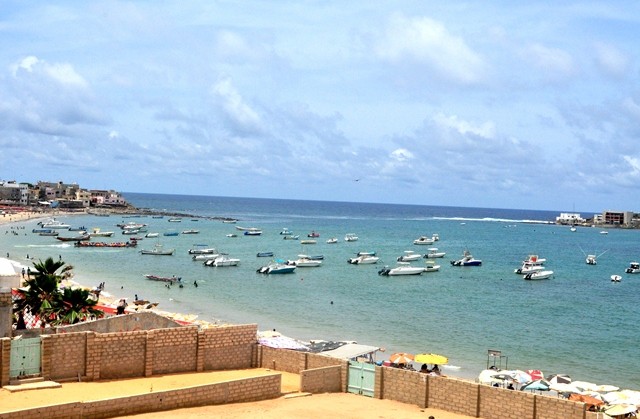
By Erin Reilley
Water Sector Risks
A climate risk assessment (Mehrotra et al., 2009) of the water sector in Dakar shows that the city’s freshwater and marine habitat resources as well as its public water infrastructure, already compromised by rapid population growth and unplanned development, are further impacted by climate change-induced coastal inundation, decreasing precipitation, and habitat loss.
The Senegalese water infrastructure partnership of Soci?©t?© Nationale des Eaux du Senegal (SONES) and Senegalaise des Eaux (SDE) does an exemplary job of meeting the infrastructure needs of urban dwellers (Torres et al. 2011, see also Gulyani et al. 2010), implementing effective models of potable water delivery and wastewater conveyance with international and private support. However, climate change is not one of SONES’ planning considerations (Torres et al. 2011), and much of the new sewerage infrastructure is within the area of Dakar that is most prone to coastal inundation (Dennis et al. 1995), along with the City’s only functioning wastewater treatment plant (World Bank, 2008).
Over 80% of the City’s sewage is released untreated into the coastal ecosystem, which also suffers greatly from the stresses of climate change, industrial emissions, and development. This ecosystem provides essential protein for the local population and supports a local fishing industry (World Bank, 2008).
Additionally, sea level rise may exacerbate salinization of the aquifers that supply 80% of region’s drinking water (Dennis et al. 1995). These aquifers are already stressed by high levels of extraction, contamination by human activity in the Niayes, and decreasing precipitation (Work Bank, 2008) caused by climate change.
Adaptation and Mitigation Challenges
Several key water infrastructure improvements should be pursued, including reconstruction of the City’s two inoperable wastewater treatment plants as well as a diffused rainwater capture system for use during Senegal’s rainy season.
However, structural challenges exist with regard to the commune-level pursuit of relevant water resource protection measures. Traditional adaptation and mitigation response, such as land use planning and environmental regulations, are out of the commune’s jurisdiction, owing to Senegal’s model of centralized authority. Further, the Senegalese framework for environmental management is derived from natural resource management; it is not suited to deal with climate change, or environmental regulation (World Bank, 2008). Poor vertical coordination further reduces the influence that the Commune can exert.
Local agency also faces funding constraints. SONES faces an annual funding gap of approximately 28% of its spending needs. The Commune of Dakar is ill equipped to take on any new water protection or infrastructure responsibilities, operating on an annual budget of only approximately USD 62.3 million (2010 dollars); the Commune also faces a general shortage of technical expertise and low awareness of climate change risks (Wang et al. 2009).
Policy Recommendations
The Mayor’s office should work with the Senegalese government to secure international support to create a Commune-level water protection agency. Technical training, capacity building, legal assistance, and funding should be secured to charter an agency with a mission to maintain freshwater and marine water resources in the face of population growth and climate change. The agency should be given regulatory and enforcement authority, some of which will be devolved from national authorities. The Agency should have the ability to coordinate with SONES/SDE as they expand their service areas, to influence cross-sector planning efforts (such as preventing overpaving as transportation and housing is improved), and raise a budget through levies or polluter fines to fund its operating budget and the aforementioned infrastructure.
References
Dennis, K.C, Niang-Diop, I., & Nicholls, R.J. (Spring 1995). Sea level rise and Senegal: Potential Impacts and Consequences [Special Issue]. Journal of Coastal Research, 14, 243-261
Gulyani, S., Debrata, T., Darby, J. (2010). Poverty, Living Conditions, and Infrastructure Access: a comparision of slums in Dakar, Johannesburg and Nairobi. (Policy Research Working Paper 5388) The World Bank, Africa Region, Sustainable Development Division.
Mehrotra, S., C.E. Natenzon, A. Omojola, R. Folorunsho, J. Gilbride & C. Rosenzweig. (2009). Framework for city climate risk assessment. Washington, DC: World Bank.
Torres, C., Briceno-Garmendia, C.M., and Dominguez, C. (2011). Senegal’s infrastructure: a Continental Perspective (Country Report 63100) The World Bank, International Bank for Reconstruction and Development. Retrieved from http://www-wds.worldbank.org
Wang, H.G, Montoliu-Munoz, M., the Geoville Group & Gueye N.F.D. (2009). Preparing to manage natural hazards and climate risks in Dakar, Senegal: a spatial and institutional approach (Pilot Study Report). Retrieved from http://www-wds.worldbank.org
World Bank, Sustainable Development Department, Africa Region. (2008). Senegal country environmental analysis (World Bank Report No. 48804-SN). Retrieved from http://www-wds.worldbank.org
This article is a product of Professor Shagun Mehrotra’s Climate Change and Cities class. Views expressed are entirely those of the individual author.